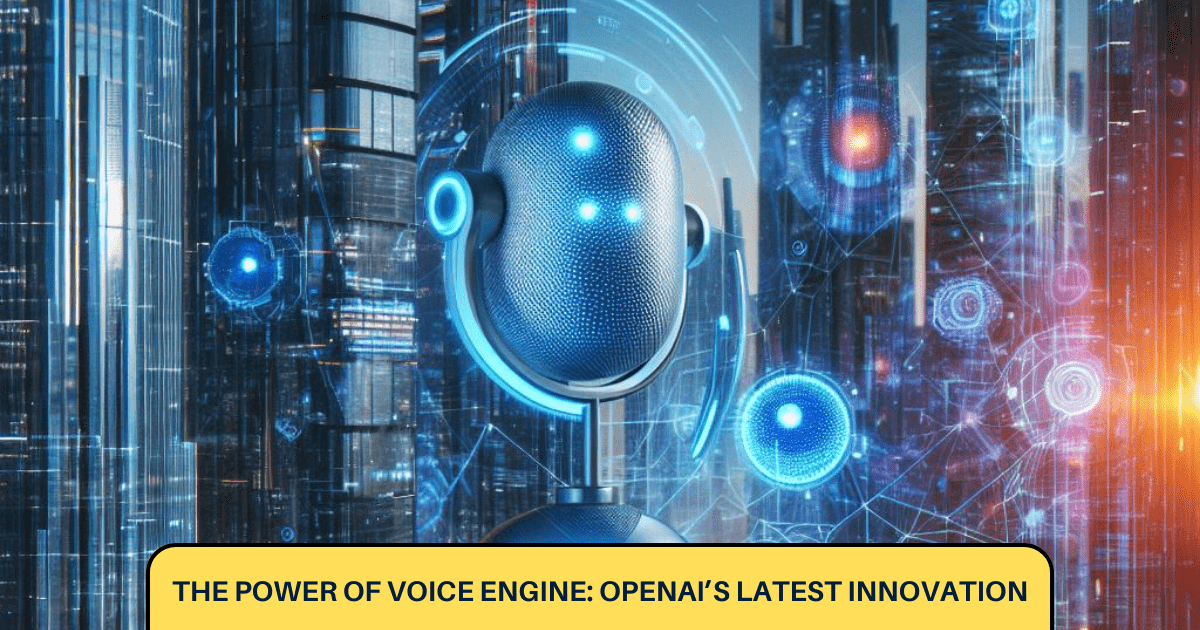Discover how Voice Engine revolutionizes voice cloning technology. Explore its potential applications, safety measures, and the challenges of responsible deployment.
OpenAI’s latest announcement has introduced a groundbreaking AI innovation: the Voice Engine. This remarkable tool can clone any voice using a mere 15-second audio sample. Imagine the possibilities: individuals who have lost their voices could communicate in their familiar tones, and movie studios could seamlessly dub films and TV shows with actors’ authentic voices.
Voice Engine
However, with great power comes great responsibility. The release of Voice Engine also raises concerns about potential misuse. Let’s delve into the details:
Political Manipulation: Malicious actors might clone the voices of politicians or celebrities to sway public opinion.
Social Engineering Attacks: Someone could deceive coworkers or family members by using a cloned voice, potentially leading to harmful consequences.
Authentication Vulnerabilities: Some banks rely on voice authentication for customer verification. Cloning voices could compromise security.
OpenAI is taking a cautious approach to Voice Engine’s broader release. The company aims to foster a dialogue on responsible deployment. Here’s how they’re addressing safety:
- Usage Policies: Testers must adhere to policies that prohibit impersonation without consent or legal rights.
- Transparency: Generated voices are labeled as AI-created, and audio clips may contain watermarks.
- Engaging Partners: OpenAI collaborates with partners across various sectors to incorporate feedback.
While Voice Engine’s potential is immense, responsible deployment remains critical. OpenAI’s commitment to safety and collaboration will shape its future impact. It’s a delicate balance between innovation and safeguarding against misuse.
Technical details of Voice Engine, OpenAI’s groundbreaking AI innovation.
Development Timeline:
- Voice Engine was first developed in late 2022.
- It powers text-to-speech APIs and two ChatGPT voice-based features: ChatGPT Voiceand Read Aloud.
Voice Cloning Process:
- Voice Engine can clone a person’s voice using a sample as short as 15 seconds.
- The AI model analyzes the unique cadence, intonations, and other vocal characteristics to create a convincing voice replica.
Potential Applications:
- Voice Restoration: Individuals who have lost their voices can communicate using their familiar tones.
- Dubbing in Entertainment: Movie studios can seamlessly dub films and TV shows with actors’ authentic voices.
Safety Measures:
- Usage Policies: Testers must adhere to policies that prohibit impersonation without consent or legal rights.
- Transparency: Generated voices are labeled as AI-created, and audio clips may contain watermarks.
- Collaboration: OpenAI engages with partners across various sectors to incorporate feedback.
Challenges and Risks:
- Misuse: Cloning voices opens the door to potential abuse, such as political manipulation or social engineering attacks.
- Authentication Vulnerabilities: Some banks use voice authentication; cloning voices could compromise security.
Future Deployment:
- OpenAI aims for responsible deployment.
- A dialogue on synthetic voice usage is essential.
- The company is actively engaging with partners to shape Voice Engine’s impact.
Remember, while Voice Engine’s potential is immense, responsible deployment remains critical. Balancing innovation with safeguards against misuse is crucial for its success .
Limitations associated with Voice Engine, OpenAI’s latest innovative voice cloning technology:
Short Audio Samples:
- Voice Engine requires a minimum of 15 secondsof audio to clone a voice.
- It may struggle with very brief samples or noisy recordings.
Limited Training Data:
- The quality of voice cloning heavily depends on the available training data.
- If the original voice sample lacks diversity or covers a narrow range, the cloned voice may not be as versatile.
Artifacts and Imperfections:
- Cloned voices may exhibit artifacts, such as unnatural pauses or glitches.
- Achieving perfect replication is challenging due to the complexity of human speech.
Speaker-Specific Characteristics:
- Voice Engine may struggle with extreme accents, dialects, or unique speech patterns.
- It might not accurately capture individual idiosyncrasies.
Ethical and Legal Concerns:
- Cloning voices raises ethical questions about consent and privacy.
- Misuse, such as impersonation or manipulation, is a significant concern.
Lack of Emotional Context:
- Voice Engine focuses on replicating speech but may not convey emotional nuances.
- Emotional tone, stress, or sentiment may not be accurately reproduced.
Resource Intensive:
- Training and deploying Voice Engine require substantial computational resources.
- Real-time applications may face latency challenges.
User Adaptation:
- Users may need time to adjust to hearing their own voice replicated by an AI system.
- Psychological factors could impact acceptance.
Uncertainty in Novel Scenarios:
- Voice Engine’s performance in novel scenarios or with unique voices remains uncertain.
- Extensive testing and adaptation are necessary.
Responsible Deployment:
- OpenAI acknowledges the potential for misuse and is cautious about broader release.
- Ensuring responsible usage and preventing abuse is an ongoing challenge.
Please note that these limitations are based on general considerations for voice cloning technology. Feel free to ask if you need further details or have additional questions.
Conclusion
This groundbreaking AI innovation promises to transform communication, accessibility, and entertainment. Yet, with great power comes great responsibility.
OpenAI’s cautious approach is commendable. By engaging with partners, incorporating feedback, and emphasizing transparency, they aim to navigate the delicate balance between progress and potential misuse. The educational sector benefits from Voice Engine, empowering non-readers and children. Meanwhile, HeyGen’s multilingual video translation opens doors to global storytelling.
Disclaimer:- Just recently OpenAI revealed more details about a new voice engine. In this post we talk about OpenAI voice engine. All the information so far in this post has been given on the basis of information found on the Internet and Open AI platform.
In this post, an attempt has been made to know what is its strength or what is its weakness, yes, all things are based on human imagination.
Also Read:- Best Course After 12th Commerce – Career Options 2024
